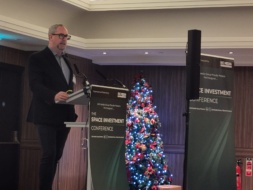Eutelsat’s €1.35B fundraise, expected to close before the end of the year, will finance the replacement of sats in its OneWeb LEO constellation.
Many of the satellites are aging out, and Eutelsat doesn’t have the cash on hand to pay for replacements—a four-year effort that’s expected to cost €2B. After that, Eutelsat is on the hook for a further €2.2B investment to help support IRIS2, an EU-led satcom constellation program.
Despite the extraordinary payments ahead, and the sizable debt Eutelsat already faces—just shy of €2.7B at the end of 2024—Eutelsat’s head of communications and investor relations, Joanna Darlington, told Payload that OneWeb is expected to be cash-flow breakeven in 2027.
The path to profit: Alongside the purchase of replacement sats—Eutelsat ordered 100 from Airbus in December, and plans to buy 340 more to launch before 2029—the new funds will be used to restructure Eutelsat’s finances. The aim is to give the company a firm financial footing to execute on its long-term growth plan, which the company calls its “telecom pivot.”
Fixed and mobile connectivity revenues are increasing alongside declining video revenues, and the company’s new CEO—Jean-François Fallacher, formerly the head of Orange France—is driving the shift to take on more telecom business going forward.
Top to-do: First thing’s first, the company has to get out from under all that debt. At the end of 2024, Eutelsat’s had nearly 4x more debt than adjusted EBITDA. Its goal is to decrease this ratio to 2.5x by June 2026, Darlington said.
For a cash boost in the short term, Eutelsat is selling passive ground station assets that will net the company €500M—about half a year of revenue. The two-part fundraise, expected to close this year, will also deepen the French government’s stake in the company from 13% to nearly 30%.
Eutelsat’s plan is to make moves that would likely improve its credit rating, specifically with its restructured debt and greater government backing. Their rating is now at a junk-adjacent position, after being downgraded by Fitch Ratings in March.
On the bright side: Eutelsat has €3.6B in revenue backlog, which it expects to close in the next three years. Eutelsat’s financial outlook paints a bright picture of the future, one with an exploding market for satellite connectivity.
- The company expects the total market for GEO and non-GEO sats to increase from €6.5B in 2023 to nearly €23B in 2033.
- In the same timeframe, it expects the total number of connected ships to double, and the number of connected planes to triple.
- Eutelsat expects its €2.2B contribution to IRIS2 to net the company €6.5B in revenues during a 12-year period.
- Eutelsat also signed a 10-year, €1B deal with the French Armed Forces Ministry to provide satcom services, an agreement that could provide a framework for more public-private partnerships with other European states.
What competition? While Eutelsat is often framed as a sovereign option for European customers looking to get away from SpaceX Starlink, the company sees the market as big enough for both businesses to co-exist.
“Most of those people that we work with are buying Starlink as well. It’s not an either-or,” Darlington said. “I think Starlink is, and will remain, a redoubtable operator…There’s no business on this planet that I know of which has a single company monopoly. Nobody wants that.”
From Eutelsat’s perspective, while the companies compete in securing commercial customers, both businesses have their strong suits elsewhere in the market. Starlink dominates the consumer connectivity market, and is moving into direct-to-device, while Eutelsat is winning the bulk of the government business in Europe.
Starlink is also facing increasing headwinds in Europe—in Italy, a potential €1.6B deal with Starlink has stalled, and Germany has funded Eutelsat user terminals as a Starlink alternative in Ukraine. If European governments continue to focus their defense space investments in homegrown options, it goes without saying that Eutelsat—as the largest constellation in town—will win out.




